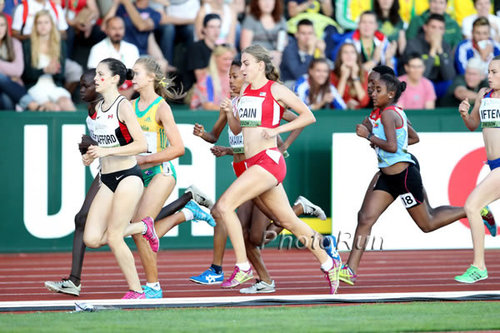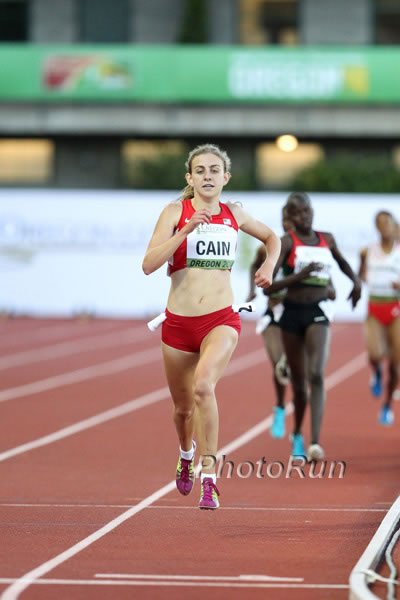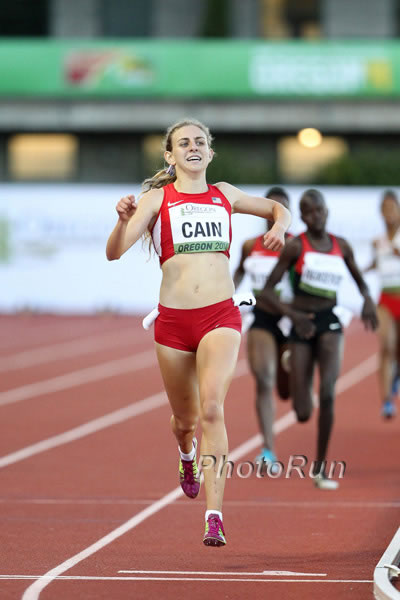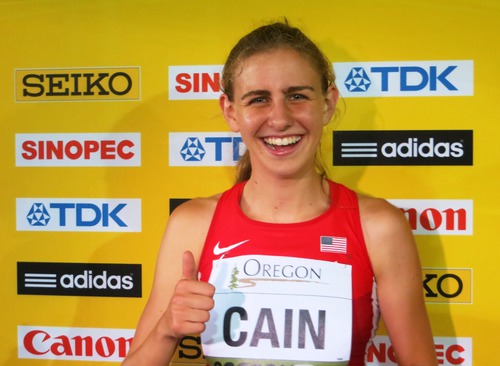RelatedPosts
CAIN TAKES 3000M GOLD AT IAAF WORLD JUNIOR CHAMPIONSHIPS
By Chris Lotsbom, @chrislotsbom
(c) 2014 Race Results Weekly, all rights reserved
EUGENE, OREGON (24-Jul) — A special, palpable feeling of excitement filled the air here at historic Hayward Field this evening, as if each and every one of the 8,112 people in attendance knew history was going to be made when Mary Cain, the 18-year-old sensation from Bronxville, N.Y., toed the line in the women’s 3000m. Fans sporting the red, white, and blue anticipated the nation’s first medal ever in the discipline, a desire Cain fulfilled thanks to a killer kick with 200 meters remaining. Breaking from her challengers with seeming ease, the Nike Oregon Project athlete timed a personal best of 8:58.48 to bring the Hayward faithful to their feet.
“The last 50 meters I just felt so good. I know you’re not really supposed to look up at the screen, but I still was looking up and was like, ‘Oh my gosh I’m in the lead,” said Cain, re-living the moment with an American flag and a Twix candy bar in her hands. “There was nowhere else that they would have been that loud for me. It was surreal.”
Through 1000 meters in 3:03.84, Cain found herself tucked in the middle of the 16 woman field. A blanket could have covered the tightly bunched group, as athletes from across the globe got to know one another with elbows and minor shoves. Leading out front were Kenyan’s Lilian Kasait Rengeruk and Valentina Chepkwemoi Mateiko.
By 1200 meters, Rengeruk had had enough of the pedestrian pace, surging to string out the field. Following her were Mateiko, Ethiopia’s Etagegn Woldu, Eritrea’s Weini Kelati, Cain, and three others.
Sticking to her pre-race plan, Cain remained calm and didn’t touch the lead in the slightest; coach Alberto Salazar had given her strict orders not to make a move until the final lap.
With the clock reading 6:07.39 at 2000 meters, it was Mateiko’s time to lead. Still, a pack of six worked their way around the track together. Cain, sixth at that point, was running well within her capabilities.
“Most World Championships races are slow in the beginning, especially in the longer distances. So I was mentally, physically prepared for that. I knew there’d be some surges in there, some fartleks,” said Cain. “With that being said, if it was going to go 8:40 I was going to go with them.”
Appearing to get antsy as the group approached the bell lap, Cain advanced into third. However, the move briefly backfired, boxing her in behind the two Kenyans, with Ethiopia’s Woldu to her immediate right.
Around the bend and entering the backstretch with 300 meters left, however, the seas briefly parted. Cain passed Woldu, then Mateiko, and slipped by Rengeruk after making the slightest bit of contact.
From there, the Bowerman Curve and famed Hayward Field homestretch was hers to conquer all alone. Taking a peek up at the video board, Cain knew the title –America’s first ever in a women’s event over 800 meters at these championships– was hers. Cain’s final circuit of the track was clocked at under 63 seconds.
“That last 120 I really made my move. At first there was a little bit of a stumble, but if anything I think that just got me going quicker because I immediately just got up and started full sprint mode,” Cain said in her typical, enthusiastic tone. “You know, I feel amazing. That was just crazy! I got the flag here, we’re going to hear the national anthem later [tomorrow], I’m just really pumped.”
Celebrating in style, Cain chose to do her victory lap with American teammate Stephanie Jenks, who finished 15th in 9:31.47. Together, the pair posed for numerous selfie pictures and slapped high fives.
“I wanted to share that with her because she’s been amazing,” said Cain. “It reminds me why I love to run, because there are just amazing spirits in the sport and you meet such great people.”
Speaking to Race Results Weekly, Alberto Salazar was proud of Cain, whom he’s guided since her junior year of high school.
“I’m really pleased with it. The race was the way I thought it would go, a nine minute race,” he said. “The plan was to wait to 200 to go no matter what. It was perfect. If they wanted to make it a 200mrace, fine.”
Taking second was Rengeruk in 9:00.53, who explained to reporters that she injured her leg on the final lap.
“I felt pain,” she said, pointing at her left ankle. “Nothing happened in that pass [meaning it wasn’t from when Cain went by]. I feel fine, just fine.”
Mateiko rounded out the top three in 9:00.53, followed by Japan’s Nozomi Musembi Takamatsu (9:02.85) and Ethiopia’s Woldu in 9:06.42.
In the much-anticipated women’s 800m final, last year’s World Youth Championships gold medalist, Anita Hinriksdottir of Iceland, took the race out at a furious pace. Bolting to the front around the first turn, she strode down the backstretch with a big lead, then clicked through 400m in a blistering 56.33. She soon realized her mistake, and was forced to slow down.
“I don’t know what’s wrong with me,” she told a small group of reporters after the race. “I ran really bad yesterday and I was lucky to get into the final.”
But her luck soon turned bad. With abou
t 250 meters to go, Cuba’s Diago Sahily and Kenya’s Margaret Wambui overtook her, and turned the race into a two-woman battle. The pair came around the Bowerman Curve together, and the nearly 6-foot tall Wambui –a virtual unknown even in Kenya– motored away to win by two seconds in 2:00.49. Her time was a personal best by a whopping four seconds.
“I thank God for that win, that victory he has given to me,” said Wambui, who is from the village of Endarasha in central Kenya and is a Kikuyu. “I’m very happy.”
Wambui, a former volleyball player who has only been training with a coach for about two years, knew that beating Diago, who has a 1:57.74 personal best, would be very difficult. So, she keyed off of her Cuban rival, and waited to strike.
“She’s very tough,” she said of the Diago. “I was trying to compete with her because she was champion. I was trying to take that gold.”
Diago took the silver in 2:01.11, while behind her Australia’s Georgia Wassall passed the flagging Hinriksdottir on the final turn, to get bronze. Exhausted and dejected Hinriksdottir stepped off the track with 80 meters to go, and sat down on the infield looking stunned. Wassall, however, was elated.
“The other girls got tired, but I executed my race plan and it paid off,” Wassall, who ran 2:02.71, told IAAF interviewers.
The men’s 1500m was a classic bump-and-shove, sit-and-kick affair, with the win going to Kenya’s Jonathan Sawe, the 2011 IAAF World Youth Championships bronze medalist, in 3:40.02. Sawe –whose listed age is 19 but who looks a bit older– led most of the race with teammate Hillary Ngetich. The duo were at the front at 400m (58.23), 800m (2:03.31) and at the bell (2:46.05). Remarkably Ngetich said he knew at that point he had the race won.
“The big advantage that I have is that I have a strong finishing kick,” he said in Swahili, his words translated by Kenyan reporter Elias Makori. “So, I’m normally comfortable to stay in the pack until 400 to go. It’s easy for me to kick to the finish.”
While Ngetich, Djibuti’s Abdi Mouhyadin, and Brazil’s Thiago Andre battled for position, Sawe was able to hit his full stride in the last 200m, and run away with the race, clocking his final lap in 54 seconds. Nonetheless, he still looked over his shoulder five times to make sure he had the victory.
“I was looking to see if anybody was going to kick,” said Sawe, laughing. “I kept checking just to be sure.”
Behind Sawe, Mouhyadin closed very strongly to move from fourth to second in the last 40 meters, clocking 3:41.38 to take the silver medal. Ngetich held on for third in 3:41.61.
Distance action continues here in Eugene tomorrow with the first round of both the women’s 1500m and men’s 800m, and the men’s 5000m final.
PHOTO: Mary Cain gives a thumbs-up after winning the 3000m at the IAAF World Junior Championships in Eugene, Or
e., in a personal best 8:58.48 (photo by Chris Lotsbom for RaceResults Weekly)
Author

Larry Eder has had a 52-year involvement in the sport of athletics. Larry has experienced the sport as an athlete, coach, magazine publisher, and now, journalist and blogger. His first article, on Don Bowden, America's first sub-4 minute miler, was published in RW in 1983. Larry has published several magazines on athletics, from American Athletics to the U.S. version of Spikes magazine. He currently manages the content and marketing development of the RunningNetwork, The Shoe Addicts, and RunBlogRun. Of RunBlogRun, his daily pilgrimage with the sport, Larry says: "I have to admit, I love traveling to far away meets, writing about the sport I love, and the athletes I respect, for my readers at runblogrun.com, the most of anything I have ever done, except, maybe running itself." Also does some updates for BBC Sports at key events, which he truly enjoys. Theme song: Greg Allman, " I'm no Angel."
View all posts
























